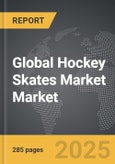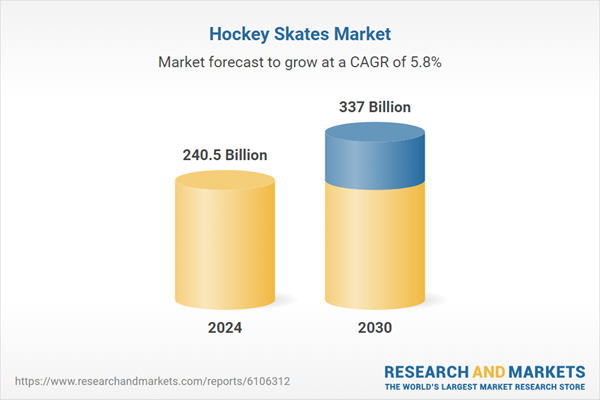Global Hockey Skates Market - Key Trends & Drivers Summarized
How Are Evolving Player Needs Reshaping the Design and Functionality of Modern Hockey Skates?
The design and engineering of hockey skates have undergone significant transformation in response to changing player expectations, competitive intensity, and advances in materials science. Traditionally, hockey skates were built for durability and basic support, but today's skates must meet the demands of a sport that is faster, more physical, and increasingly technique-driven. Players across all levels now require skates that combine lightweight construction with enhanced stability, ankle support, and responsiveness. Manufacturers have responded by incorporating high-grade carbon fiber composites, thermoformable materials, and precision-fit liners that mold to the skater's foot for optimal energy transfer and comfort. Customization has become a central focus, with brands offering fit profiles for different foot shapes, adjustable tongues, and lace-lock systems to accommodate varying performance styles. Blade holders and steel runners are also being optimized for quicker turns and better ice feel, with some models allowing easy runner replacement without the need for tools. The focus is no longer just on speed or protection in isolation, but on achieving the right balance between both. As the game evolves, so does the demand for skates that allow players to change direction swiftly, absorb impacts from checks and pucks, and maintain control through tight maneuvers. This shift toward high-performance design is particularly evident in professional and amateur leagues, where marginal gains in agility and foot control can influence game outcomes. Consequently, manufacturers are increasingly involving athletes in the R&D process, ensuring that new skate models reflect real-world performance needs and preferences.What Technological Innovations Are Driving the Next Generation of Hockey Skate Development?
Technological innovation is playing a critical role in the evolution of hockey skates, enabling manufacturers to produce equipment that is lighter, stronger, and more adaptable to individual player needs. One of the most important advances has been in the use of thermoformable boot materials that allow players to heat-mold their skates for a truly customized fit. This technology enhances energy efficiency by minimizing foot slippage and maximizing contact between the foot and the boot. At the same time, new composite structures are being developed to reduce overall skate weight without compromising durability or protection. Advances in 3D printing and scanning are also enabling bespoke skate production, where players can receive equipment tailored precisely to their foot dimensions and skating mechanics. Blade innovations are another area of intense focus, with manufacturers introducing interchangeable steel systems, enhanced sharpening profiles, and coatings that reduce friction and increase glide. Some skates now include embedded microchips or sensors that collect data on stride length, pressure distribution, and turning dynamics, allowing players and coaches to analyze performance in real time. Enhanced tongue padding, integrated ankle support technologies, and asymmetrical lacing patterns are being engineered to reduce lace bite and improve foot lock. Even the insoles of modern skates are being reimagined with moisture-wicking, antimicrobial, and impact-absorbing materials. These cumulative innovations are redefining what is possible in hockey footwear, providing athletes with tools that directly support their speed, agility, and endurance on the ice.How Are Consumer Preferences and Market Demographics Shaping the Hockey Skates Industry?
Consumer expectations and demographic shifts are significantly influencing the development and marketing of hockey skates across different regions. As hockey continues to expand beyond its traditional strongholds in North America and Northern Europe, there is a growing base of beginner and recreational players entering the sport. This broader consumer spectrum has created a need for product lines that cater not only to elite athletes but also to casual skaters, youth players, and newcomers. Brands are diversifying their offerings to include skates at various price points and complexity levels, ensuring accessibility without sacrificing basic performance or safety features. A growing emphasis on youth and development leagues is encouraging manufacturers to prioritize fit, protection, and ease of use in junior and intermediate models. At the same time, rising female participation in hockey is prompting companies to produce skates specifically designed for anatomical differences, ensuring better comfort and reduced injury risk. Consumer preferences are also tilting toward sustainability and transparency, with buyers increasingly favoring eco-conscious manufacturing practices and materials that reduce environmental impact. Online platforms and digital marketing campaigns are empowering consumers to research, compare, and customize their skate purchases, elevating the importance of detailed product information and virtual fitting tools. Additionally, social media and athlete endorsements play a significant role in shaping brand perceptions and influencing buying decisions. As consumers become more informed and diverse in their needs, the hockey skate market is adapting with inclusive product strategies and a stronger focus on personalization, education, and value delivery.What Core Factors Are Driving Global Growth in the Hockey Skates Market?
The growth in the hockey skates market is fueled by a confluence of sporting, technological, and economic factors that are driving both demand and innovation on a global scale. One of the primary drivers is the increasing popularity of ice hockey and related skating sports in emerging regions such as Asia-Pacific and parts of South America, where infrastructure investment and grassroots programs are helping the sport gain a foothold. In established markets like Canada, the United States, Sweden, and Finland, a strong culture of youth hockey, collegiate leagues, and professional competition continues to generate consistent demand for equipment upgrades and replacements. Technological advancements, as seen in materials, ergonomics, and fit customization, are not only enhancing performance but also motivating consumers to invest in newer models. Rising disposable incomes in key demographics are allowing more consumers to access premium skate offerings, while equipment financing programs and flexible retail models are making high-end skates more attainable. Additionally, the post-pandemic resurgence of recreational sports and community programs has revitalized interest in skating as both a competitive and fitness-oriented activity. The growth of e-commerce and direct-to-consumer sales channels has further expanded market access, allowing brands to reach new customer segments and streamline the buying experience. Collaborations between skate manufacturers, professional athletes, and sports academies are creating valuable brand trust and increasing market penetration. Together, these factors are fostering an environment in which the hockey skates market is poised for sustained expansion, marked by innovation, inclusivity, and heightened global participation.Report Scope
The report analyzes the Hockey Skates market, presented in terms of market value (US$). The analysis covers the key segments and geographic regions outlined below:- Segments: Type (Player Skates, Goalie Skates, Recreational Skates, Inline Hockey Skates, Custom Skates); Application (Ice Hockey Application, Roller Hockey Application, Recreational Skating Application, Professional Leagues Application).
- Geographic Regions/Countries: World; United States; Canada; Japan; China; Europe (France; Germany; Italy; United Kingdom; Spain; Russia; and Rest of Europe); Asia-Pacific (Australia; India; South Korea; and Rest of Asia-Pacific); Latin America (Argentina; Brazil; Mexico; and Rest of Latin America); Middle East (Iran; Israel; Saudi Arabia; United Arab Emirates; and Rest of Middle East); and Africa.
Key Insights:
- Market Growth: Understand the significant growth trajectory of the Player Skates segment, which is expected to reach US$153.8 Billion by 2030 with a CAGR of a 6.7%. The Goalie Skates segment is also set to grow at 3.8% CAGR over the analysis period.
- Regional Analysis: Gain insights into the U.S. market, valued at $65.5 Billion in 2024, and China, forecasted to grow at an impressive 9.3% CAGR to reach $68.8 Billion by 2030. Discover growth trends in other key regions, including Japan, Canada, Germany, and the Asia-Pacific.
Why You Should Buy This Report:
- Detailed Market Analysis: Access a thorough analysis of the Global Hockey Skates Market, covering all major geographic regions and market segments.
- Competitive Insights: Get an overview of the competitive landscape, including the market presence of major players across different geographies.
- Future Trends and Drivers: Understand the key trends and drivers shaping the future of the Global Hockey Skates Market.
- Actionable Insights: Benefit from actionable insights that can help you identify new revenue opportunities and make strategic business decisions.
Key Questions Answered:
- How is the Global Hockey Skates Market expected to evolve by 2030?
- What are the main drivers and restraints affecting the market?
- Which market segments will grow the most over the forecast period?
- How will market shares for different regions and segments change by 2030?
- Who are the leading players in the market, and what are their prospects?
Report Features:
- Comprehensive Market Data: Independent analysis of annual sales and market forecasts in US$ Million from 2024 to 2030.
- In-Depth Regional Analysis: Detailed insights into key markets, including the U.S., China, Japan, Canada, Europe, Asia-Pacific, Latin America, Middle East, and Africa.
- Company Profiles: Coverage of players such as Abcam plc, AbMole BioScience, Alfa Chemical Co. Ltd, Biosynth, Capot Chemical Co. Ltd and more.
- Complimentary Updates: Receive free report updates for one year to keep you informed of the latest market developments.
Some of the 39 companies featured in this Hockey Skates market report include:
- ALKALI Hockey
- American Athletic
- Bauer Hockey
- Botas (Vasky)
- CCM Hockey
- Edea Skates
- Graf Skates
- Jackson Ultima Skates
- K2 Sports
- Mission Hockey (Bauer Hockey)
- Powertek Hockey
- Reebok Hockey (Authentic Brands Group)
- Risport
- Roces Srl
- Sherwood Hockey
- Source for Sports
- STX
- Tour Hockey
- True Hockey
- Warrior Sports
This edition integrates the latest global trade and economic shifts into comprehensive market analysis. Key updates include:
- Tariff and Trade Impact: Insights into global tariff negotiations across 180+ countries, with analysis of supply chain turbulence, sourcing disruptions, and geographic realignment. Special focus on 2025 as a pivotal year for trade tensions, including updated perspectives on the Trump-era tariffs.
- Adjusted Forecasts and Analytics: Revised global and regional market forecasts through 2030, incorporating tariff effects, economic uncertainty, and structural changes in globalization. Includes historical analysis from 2015 to 2023.
- Strategic Market Dynamics: Evaluation of revised market prospects, regional outlooks, and key economic indicators such as population and urbanization trends.
- Innovation & Technology Trends: Latest developments in product and process innovation, emerging technologies, and key industry drivers shaping the competitive landscape.
- Competitive Intelligence: Updated global market share estimates for 2025, competitive positioning of major players (Strong/Active/Niche/Trivial), and refined focus on leading global brands and core players.
- Expert Insight & Commentary: Strategic analysis from economists, trade experts, and domain specialists to contextualize market shifts and identify emerging opportunities.
Table of Contents
Companies Mentioned (Partial List)
A selection of companies mentioned in this report includes, but is not limited to:
- ALKALI Hockey
- American Athletic
- Bauer Hockey
- Botas (Vasky)
- CCM Hockey
- Edea Skates
- Graf Skates
- Jackson Ultima Skates
- K2 Sports
- Mission Hockey (Bauer Hockey)
- Powertek Hockey
- Reebok Hockey (Authentic Brands Group)
- Risport
- Roces Srl
- Sherwood Hockey
- Source for Sports
- STX
- Tour Hockey
- True Hockey
- Warrior Sports
Table Information
| Report Attribute | Details |
|---|---|
| No. of Pages | 285 |
| Published | December 2025 |
| Forecast Period | 2024 - 2030 |
| Estimated Market Value ( USD | $ 240.5 Billion |
| Forecasted Market Value ( USD | $ 337 Billion |
| Compound Annual Growth Rate | 5.8% |
| Regions Covered | Global |









